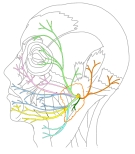後耳介筋 ( こうじかいきん、 英 : auriculais posterior muscle )
・ 概 要 |
・ 作 用 |
・ イラスト掲載サイ |
|
・ イラスト |
・ 神経 / 脈管 |
||
・ 起始 / 停止 |
・ Wikipedia |



・「 船戸和弥のHP 」には 項耳筋 という名称も見られる。
【 起 始 】: 側頭骨の乳突部の外側面 ( 胸鎖乳突筋 の停止部の上方 )
【 停 止 】: 耳介軟骨 の内側面
耳介を後上方に引き上げる。
・ 脈 管 : 支配する神経より、同名の脈管( 後耳介動脈・静脈 )によって血液のやり取りをしている可能性が高いと思われるが、それに言及している資料は見当たらない。
The posterior auricular muscle consists of two or three fleshy fasciculi, which arise from the mastoid portion of the temporal bone by short aponeurotic fibers. They are inserted into the lower part of the cranial surface of the concha.
The postauricular reflex is a vestigial muscle response in humans that acts to pull the ear upward and backward.[1] Research suggests neural circuits for pinna orienting have survived in a vestigial state for over 25 million years. It is often assumed the reflex is a vestigial Preyer reflex (also known as the pinna reflex).[2]
【 語 句 】
・ fasciculi : 束 ・ mastoid portion of the temporal bone : 側頭骨の乳突部 ・ aponeurotic : 腱膜の ・ cranial : 頭蓋の ・ concha : 甲介 ・ postauricular : 耳後部の ・ reflex : 反射作用 ・ vestigial : 痕跡の ・ neural circuits : 神経回路 ・ pinna : 耳介 ・ pinna reflex : 耳介反射







